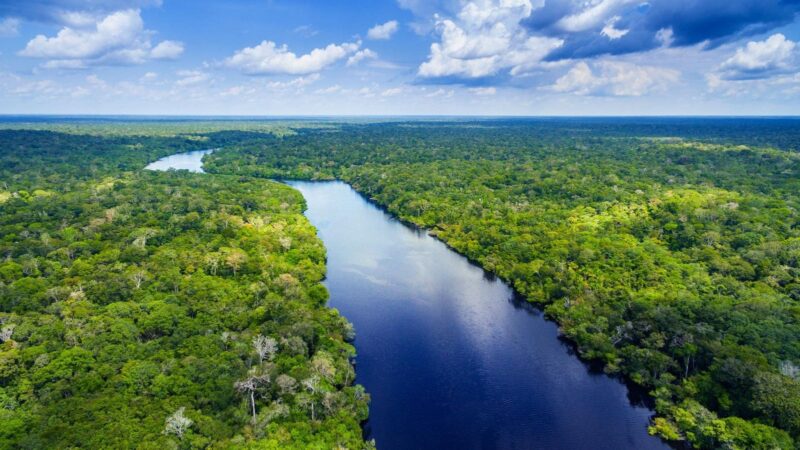Amazon river in Brazil
getty
An innovative financial model set in motion in the run-up to COP30 signals another evolution in how the private sector is ratcheting up its focus on nature loss alongside climate change.
Launched before official negotiations kicked off in the Brazilian Amazon, the Tropical Forest Forever Facility is designed to help safeguard the most critical tropical ecosystems. Unlike most rainforest protection efforts, which rely on only government funding, grants, or carbon credits, this one seeks public and private financing – and it notably promises to make money for its investors.
It’s too early to tell if the new fund will successfully attract its goal of $125 billion. Yet its introduction illustrates the inventive options that are emerging for investors and companies to contribute toward preserving the ecosystems that uphold the global economy.
Beyond this much-anticipated outcome, protecting forests remained a major topic of conversation by world leaders – along with members of the business and stakeholder communities – during COP30. But it’s not just in Brazil where nature is hard to ignore at global climate events.
Nature Climbs the Global Agenda
Earlier this year, London Climate Action Week and Climate Week NYC were both buzzing with talk of ways to address nature and biodiversity loss to meet business and environmental goals while reducing material risk and capitalizing on opportunities to build resilience across sectors. And, as at COP30, they also served as a platform for launching initiatives aimed at driving nature action, such as the release by 34 governments of a new roadmap aimed at unlocking billions in private and public sector forest finance solutions by 2030.
These prominent climate events are placing nature so high on the agenda because it has become apparent how much the pressing issues are interconnected. Nature loss drives climate change, which, in turn, accelerates nature loss – meaning it is no longer viable for companies, investors, and world governments to tackle their risks in isolation.
Ceres’ recent report spotlights the strong connection between the material financial risks related to nature and climate. The analysis showed that climate change is one of the largest drivers harming natural ecosystem services, such as pollination, rainfall, and soil maintenance, that businesses depend on. And climate impacts were found to be responsible for the greatest economic toll to companies across sectors.
But it would be a mistake to believe that addressing climate risks alone will solve the complex challenges posed by nature’s decline.
Climate Action Alone Won’t Cut It
Industries contribute heavily to all main drivers of nature loss, including land and sea use change, natural resource exploitation, pollution, and spread of invasive species. While the effects of climate change are primarily experienced globally (think super-charged hurricanes and extreme droughts), nature-related degradation by companies tends to be felt locally, in the nearby environments and communities.
For example, if a food manufacturer pollutes a river, it reduces its ability to access clean water for use as an ingredient, and in processing products and cleaning equipment.
That’s why nature action and climate action must go hand in hand.
The good news is that businesses are understanding that nature risks need to be integrated into their strategic planning, just like other risks, including climate. A slew of recently released reports by major industry initiatives illustrates the building momentum by companies and financial institutions.
Nature Action 100, a global investor-led initiative, recently showcased the progress investors are making in working with companies in industries across the economy to address nature-related financial issues.
It’s also becoming clear how essential disclosing nature risks is to being able to understand and act on them. Two years after the Taskforce on Nature-related Financial Disclosures released its disclosure recommendations, more than 700 companies and financial institutions from over 56 countries or areas have now publicly committed to getting started with nature-related reporting in line with those recommendations.
And there’s further evidence of the growing awareness among investors of the looming threat that damaging nature presents and advantages of moving swiftly to avoid escalating economic repercussions.
The Business Case is Clear
An analysis of data from more than 220 of the largest asset owners and asset managers found that the financial materiality of climate risk is now well understood by investors. Notably, nature loss is also gaining significant attention, with 60% of investors including nature-related disclosures in their transition plans.
The same could be said for companies, which are more and more factoring nature into their planning. An analysis digging into the nature strategies of 32 business representing $700 billion found that companies are increasingly recognizing nature as an enabler of climate action and long-term resilience. In fact, 94% of the analyzed companies include climate targets within their nature strategies.
The investor and company action, along with the launch of the Tropical Forest Forever Facility on the world climate stage, provides hope that the pathway for global financial flows is beginning to shift toward conserving essential natural ecosystems rather than destroying them. While this is encouraging, much more urgent business action is required to reduce systemic risks of climate change and nature loss.
Whether through implementing nature strategies, participating in related initiatives, or considering investments in financial innovations such as the Tropical Forest Forever Facility, companies and financial institutions have an important role to play in supporting global goals and protecting profit, people, and the planet.









